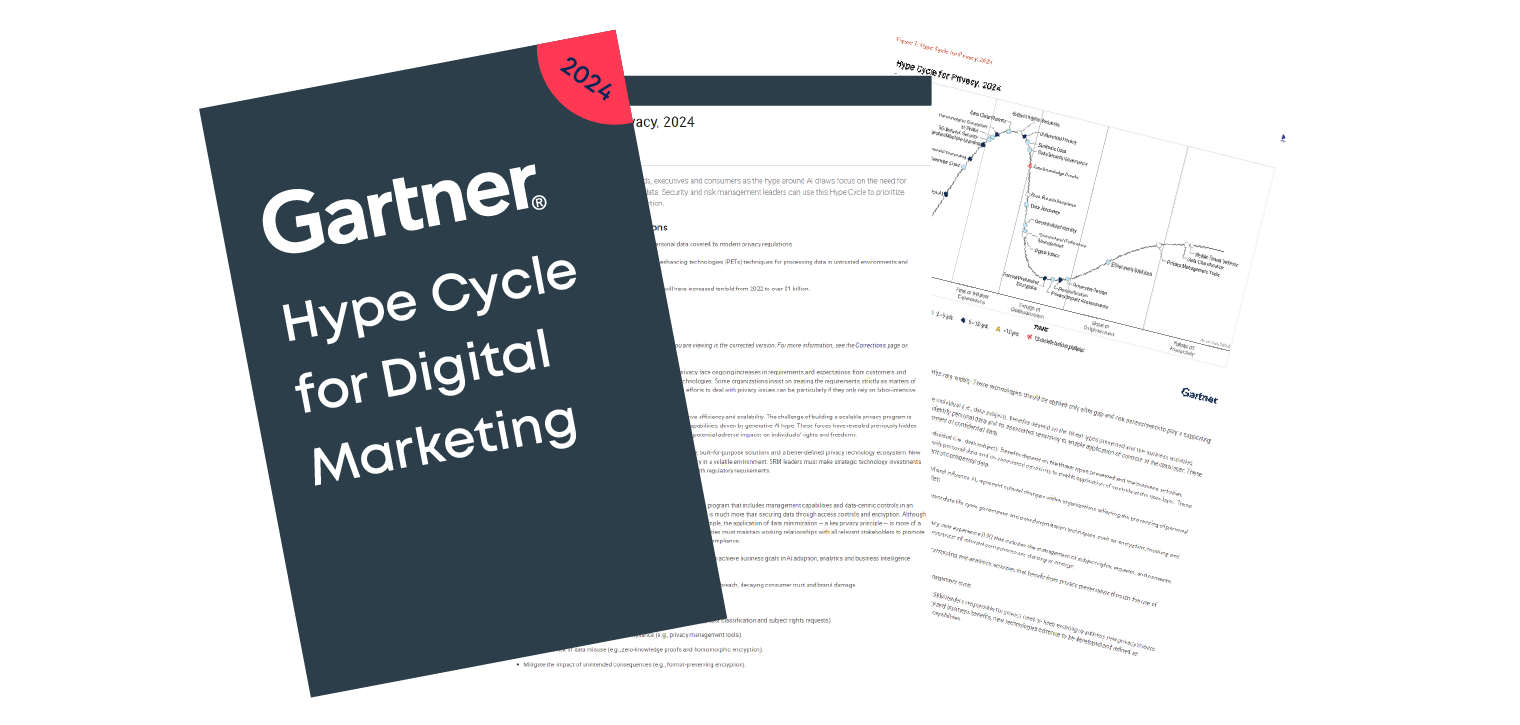Composable MarTech: Building a flexible marketing technology stack
Posted: August 29, 2024
Keeping up with MarTech innovation is like running a marathon on a treadmill that keeps speeding up. With new tools and technologies emerging almost daily, how can organizations ensure their marketing technology stack remains agile and effective?
Composable MarTech offers a groundbreaking solution. By assembling modular components, organizations can build a flexible, customized marketing technology stack that adapts to their unique needs. This approach is rapidly gaining traction as businesses strive to enhance their adaptability and responsiveness to market changes. In fact, the marketing technology industry has grown by an astounding 9,295% over the past 13 years.
This blog will delve into the concept of composable MarTech, demonstrating how it empowers organizations to create a tailored, adaptable marketing technology stack. We’ll explore the benefits, including improved adaptability, cost efficiency, and the ability to swiftly respond to evolving market conditions as well as how privacy considerations should be a the forefront of your marketing decision making.
What is composable MarTech?
Composable MarTech refers to the practice of building a marketing technology stack using modular, interchangeable components. This approach allows organizations to customize their workflows and tools to meet specific needs, rather than relying on a one-size-fits-all solution.
Key characteristics:
- Modularity: Each component of the stack can function independently and be replaced or upgraded without affecting the entire system. This flexibility ensures that businesses can adapt quickly to new technologies and market demands.
- Interoperability: The components are designed to work seamlessly together, ensuring smooth data flow and integration – maintaining a cohesive marketing strategy and avoiding data silos.
- Scalability: The stack can easily scale up or down, accommodating growth and changes in business needs, meaning that as your business grows, your technology stack can grow with it, without requiring a complete overhaul.
Examples of composable components:
These components can be combined in various ways to build a customized marketing technology stack that perfectly aligns with your organization’s specific requirements, utilizing solutions you may already recognize and already be using.
Customer Relationship Management (CRM)
- Salesforce: Salesforce CRM helps manage customer interactions and data, providing insights into customer behavior and helping to build stronger relationships.
- HubSpot: HubSpot CRM is a free CRM solution that integrates with other HubSpot tools and offers features like email tracking, live chat, and meeting scheduling.
Customer Data Platforms (CDP)
- Segment: Segment unifies customer data from various sources, creating a single customer view for personalized marketing.
- Tealium: Tealium CDP collects, unifies, and activates customer data for enhanced marketing and personalized experiences.
Analytics Tools
- Google Analytics: Google Analytics provides insights into marketing performance, helping businesses understand what’s working and what’s not.
- Adobe Analytics: Adobe Analytics offers in-depth analysis, versatile reporting, and predictive intelligence to build better customer experiences.
Marketing Automation
- Marketo: Marketo Engage automates marketing tasks and workflows, saving time and ensuring consistency in marketing efforts.
- Mailchimp: Mailchimp automates email campaigns and marketing tasks, helping to reach customers with personalized messages.
Data Management Platforms (DMP)
- Adobe Audience Manager: Adobe Audience Manager helps manage and analyze large sets of audience data, enabling more targeted advertising.
- Oracle BlueKai: Oracle BlueKai manages big data with audience segmentation and marketing campaign approaches.
The benefits of a flexible MarTech stack
A composable MarTech stack allows organizations to quickly adapt to new marketing trends and technologies. By using modular components, businesses can easily swap out or upgrade tools without overhauling the entire system. This flexibility ensures that the marketing technology stack remains current and effective in a rapidly changing digital landscape.
Using modular components can significantly reduce costs. Instead of investing in a comprehensive, all-in-one solution, companies can choose and pay for only the tools they need. This approach minimizes waste and ensures that resources are allocated efficiently.
A flexible MarTech stack enables organizations to respond swiftly to changing market conditions and customer preferences. The ability to quickly implement new tools and strategies allows businesses to stay competitive and meet customer demands more effectively.
As a business grows, its marketing needs will evolve. A composable MarTech stack can scale with the business, supporting growth without the need for extensive overhauls. This scalability ensures that the marketing technology stack can accommodate increased demand and complexity.
One of the standout benefits of composable MarTech is its ability to eliminate silos within an organization. By integrating various tools seamlessly, businesses can create a unified view of their customers and processes. This integration creates a single source of truth, simplifying workflows and enabling data to be activated across multiple business scenarios. This streamlined approach supports iterative testing and learning, enhancing overall efficiency and effectiveness.
Composable MarTech also provides a holistic understanding of customers by consolidating data from various touchpoints. This view allows businesses to activate data throughout the customer journey, ensuring consistent and personalized experiences across all channels. By leveraging this unified data, organizations can deliver tailored, omnichannel experiences that boost customer satisfaction and loyalty.
Building a composable MarTech stack
- Assessing your needs: Start by identifying the core components that align with your marketing strategy. Consider your business goals, target audience, and the specific marketing activities you need to support. This assessment will help you determine which tools and technologies are essential for your stack.
- Selecting the right tools: Choose modular tools that integrate well with your existing systems. Look for solutions that offer APIs and support seamless data exchange. Evaluate each tool based on its functionality, ease of use, and ability to meet your specific needs. Some key categories to consider include CRM, CDP, analytics, marketing automation, and content management.
- Integration and interoperability: Ensure that the components you select can work together seamlessly. Integration is crucial for maintaining a smooth workflow and ensuring that data flows freely between different tools. Look for platforms that offer pre-built integrations or support industry-standard protocols like RESTful APIs.
- Future-proofing your stack: To ensure your stack remains adaptable to future changes and growth, choose tools that are scalable and regularly updated. Stay informed about emerging technologies and trends in the MarTech space, and be prepared to incorporate new components as needed. Regularly review and update your stack to keep it aligned with your evolving business needs.
- Consent based analytics: A CMP will manage user consent across all components of your MarTech stack, ensuring that customer data is collected, stored, and used in a compliant manner as well as addressing revocation requests across all the stacks. This not only helps avoid legal penalties but also builds trust with your customers.
Role of Consent and Preference Management in composable MarTech
As digital data sets become increasingly complex and expansive, the importance of ensuring compliance with data protection regulations like GDPR and CCPA grows as well. Consent and preference management platforms (CMPs) ensures that your organization collects, stores, and uses customer data in a compliant manner, enabling organizations to not only helps avoid legal penalties but builds trust with your customers.
Managing customer preferences allows for more effective personalization. By understanding and respecting customer choices, you can tailor your marketing efforts to meet their specific needs and preferences. This leads to higher engagement and conversion rates, as customers are more likely to respond positively to personalized content.
Having a consent and preference management platform in your tech stack is essential for MarTech scalability. As your business grows and your customer base expands, the ability to manage consent and preferences efficiently becomes increasingly important. A scalable system ensures that you can handle larger volumes of data and more complex customer interactions without compromising on compliance or personalization. This scalability supports your overall marketing strategy, allowing you to maintain high standards of data management and customer engagement as you grow.
Use examples:
Here are a few examples of successful consent management implementations within composable MarTech stacks:
Retail
A retail company integrated a Consent Management Platform (CMP) into their composable MarTech stack to ensure all customer data was collected with explicit consent, the data was then used to personalize marketing campaigns, resulting in a increase in email open rates and a boost in sales. This example highlights how effective consent and preference management can lead to improved customer outcomes and business performance, while also supporting scalability
Global E-commerce Platform
A global e-commerce platform implemented a CMP to comply with GDPR and CCPA regulations. By integrating the CMP with their existing analytics and marketing automation tools, they ensured that user consent preferences were respected across all touchpoints. This integration not only helped them avoid legal penalties but also increased customer trust and engagement. The platform reported a significant reduction in opt-out rates and an increase in customer satisfaction.
Financial Services
A financial services firm used a CMP to manage consent for their various digital marketing activities. By integrating the CMP with their Customer Data Platform (CDP) and CRM, they were able to maintain a unified view of customer preferences. The platform reported a significant reduction in opt-out rates and an increase in customer satisfaction.
Healthcare Provider
A healthcare provider implemented a CMP to ensure compliance with HIPAA and other data protection regulations. By integrating the CMP with their patient management system and marketing tools, they were able to collect and manage patient consent for communication and data usage. This integration improved patient trust and engagement, resulting in higher participation rates in health programs and a 20% increase in patient satisfaction scores.
Media and Entertainment
A media and entertainment company integrated a CMP into their MarTech stack to manage user consent for data collection and targeted advertising. By ensuring that all user data was collected with explicit consent, they were able to deliver more relevant and personalized content to their audience, leading to a 15% increase in content engagement and a 10% boost in subscription rates.
Composable MarTech – including a consent strategy
As the digital marketing landscape continues to evolve, the importance of flexibility and adaptability cannot be overstated. Embracing a composable MarTech stack positions your organization to stay ahead of the curve, respond swiftly to market changes, and deliver personalized experiences that resonate with your customers.
We’ve delved into the concept of composable MarTech and its ability to empower organizations to build a flexible, customized marketing technology stack. The benefits are numerous, including enhanced adaptability, cost efficiency, agility, and scalability, highlighting the role of consent and preference management in ensuring compliance and delivering personalized experiences at scale.
If you’re ready to enhance your marketing technology stack with a composable approach, we invite you to explore how our platform can support your needs. Contact our team today or request a demo to see how our modular features can help you achieve greater flexibility and efficiency in your marketing efforts.


